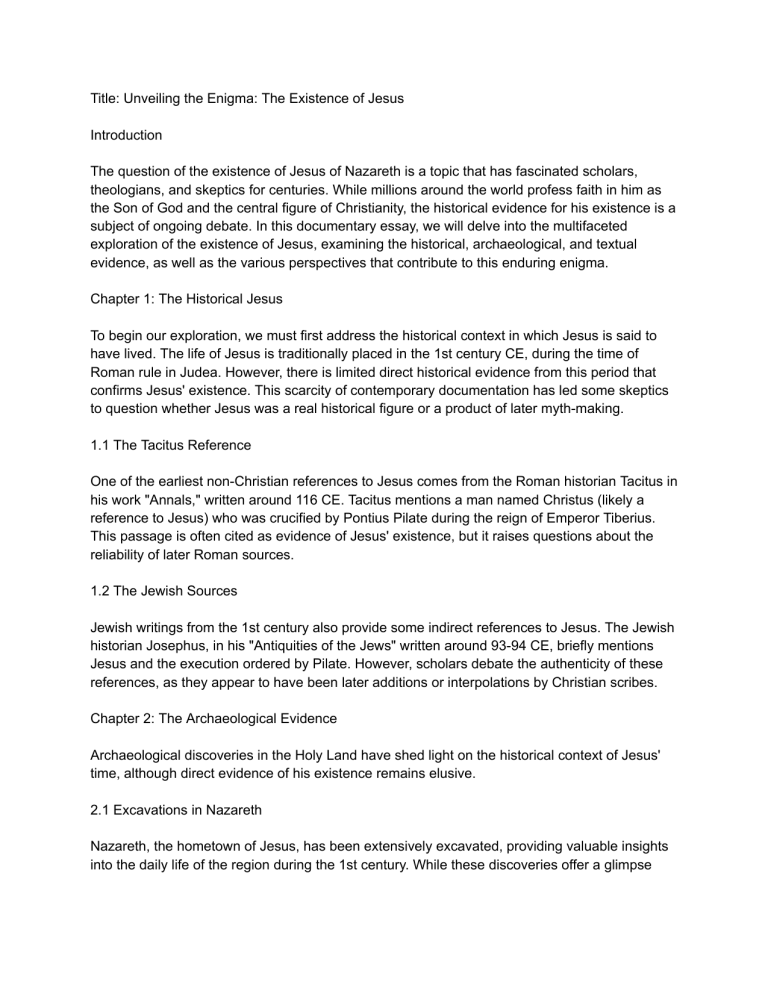
Title: Unveiling the Enigma: The Existence of Jesus Introduction The question of the existence of Jesus of Nazareth is a topic that has fascinated scholars, theologians, and skeptics for centuries. While millions around the world profess faith in him as the Son of God and the central figure of Christianity, the historical evidence for his existence is a subject of ongoing debate. In this documentary essay, we will delve into the multifaceted exploration of the existence of Jesus, examining the historical, archaeological, and textual evidence, as well as the various perspectives that contribute to this enduring enigma. Chapter 1: The Historical Jesus To begin our exploration, we must first address the historical context in which Jesus is said to have lived. The life of Jesus is traditionally placed in the 1st century CE, during the time of Roman rule in Judea. However, there is limited direct historical evidence from this period that confirms Jesus' existence. This scarcity of contemporary documentation has led some skeptics to question whether Jesus was a real historical figure or a product of later myth-making. 1.1 The Tacitus Reference One of the earliest non-Christian references to Jesus comes from the Roman historian Tacitus in his work "Annals," written around 116 CE. Tacitus mentions a man named Christus (likely a reference to Jesus) who was crucified by Pontius Pilate during the reign of Emperor Tiberius. This passage is often cited as evidence of Jesus' existence, but it raises questions about the reliability of later Roman sources. 1.2 The Jewish Sources Jewish writings from the 1st century also provide some indirect references to Jesus. The Jewish historian Josephus, in his "Antiquities of the Jews" written around 93-94 CE, briefly mentions Jesus and the execution ordered by Pilate. However, scholars debate the authenticity of these references, as they appear to have been later additions or interpolations by Christian scribes. Chapter 2: The Archaeological Evidence Archaeological discoveries in the Holy Land have shed light on the historical context of Jesus' time, although direct evidence of his existence remains elusive. 2.1 Excavations in Nazareth Nazareth, the hometown of Jesus, has been extensively excavated, providing valuable insights into the daily life of the region during the 1st century. While these discoveries offer a glimpse into the world in which Jesus may have lived, they do not provide direct evidence of his existence. 2.2 The Shroud of Turin The Shroud of Turin, a linen cloth believed by some to bear the image of Jesus, has been a subject of fascination and controversy for centuries. While carbon dating suggests that the shroud dates to the medieval period, some still argue for its authenticity. However, the shroud's connection to the historical Jesus remains unproven. Chapter 3: The New Testament and Christian Texts The primary textual sources for information about Jesus are the New Testament Gospels, written by early Christian communities. These texts provide the most detailed accounts of his life, teachings, and crucifixion. 3.1 The Synoptic Gospels The Synoptic Gospels (Matthew, Mark, and Luke) offer parallel accounts of Jesus' ministry and are considered the earliest written records of his life. Scholars analyze these texts to discern the historical Jesus beneath the layers of theological interpretation. 3.2 The Gospel of John The Gospel of John presents a unique theological perspective on Jesus and his divinity. While it contains valuable insights into early Christian beliefs, it is less commonly used as a source for reconstructing the historical Jesus. 3.3 The Gnostic Gospels The discovery of the Gnostic Gospels, such as the Gospel of Thomas and the Gospel of Mary, in the mid-20th century added complexity to the study of Jesus' life and teachings. These texts present alternative perspectives on Jesus, emphasizing spiritual knowledge and mystical experiences. Chapter 4: The Mythicist Perspective Some scholars and skeptics argue that Jesus may have been a purely mythical figure, created by early Christian communities to serve as a symbolic or allegorical figure. 4.1 Mythicist Arguments Mythicists point to the lack of contemporary, non-Christian sources that definitively confirm Jesus' existence. They argue that the early Christians borrowed elements from various mythologies to create a divine savior figure. 4.2 Counterarguments Critics of the mythicist perspective contend that it underestimates the historical reliability of the Gospels and dismisses the cumulative weight of circumstantial evidence, such as the spread of Christianity in the 1st century. Chapter 5: The Quest for the Historical Jesus Throughout history, scholars have embarked on quests to uncover the historical Jesus, aiming to separate the man from the myth. These quests have produced various portraits of Jesus, reflecting changing cultural and scholarly perspectives. 5.1 The First Quest The First Quest for the historical Jesus took place in the 18th and 19th centuries, with scholars like Albert Schweitzer and David Strauss attempting to reconstruct the life of Jesus using historical-critical methods. 5.2 The Second Quest The Second Quest emerged in the mid-20th century, with scholars like Rudolf Bultmann and






